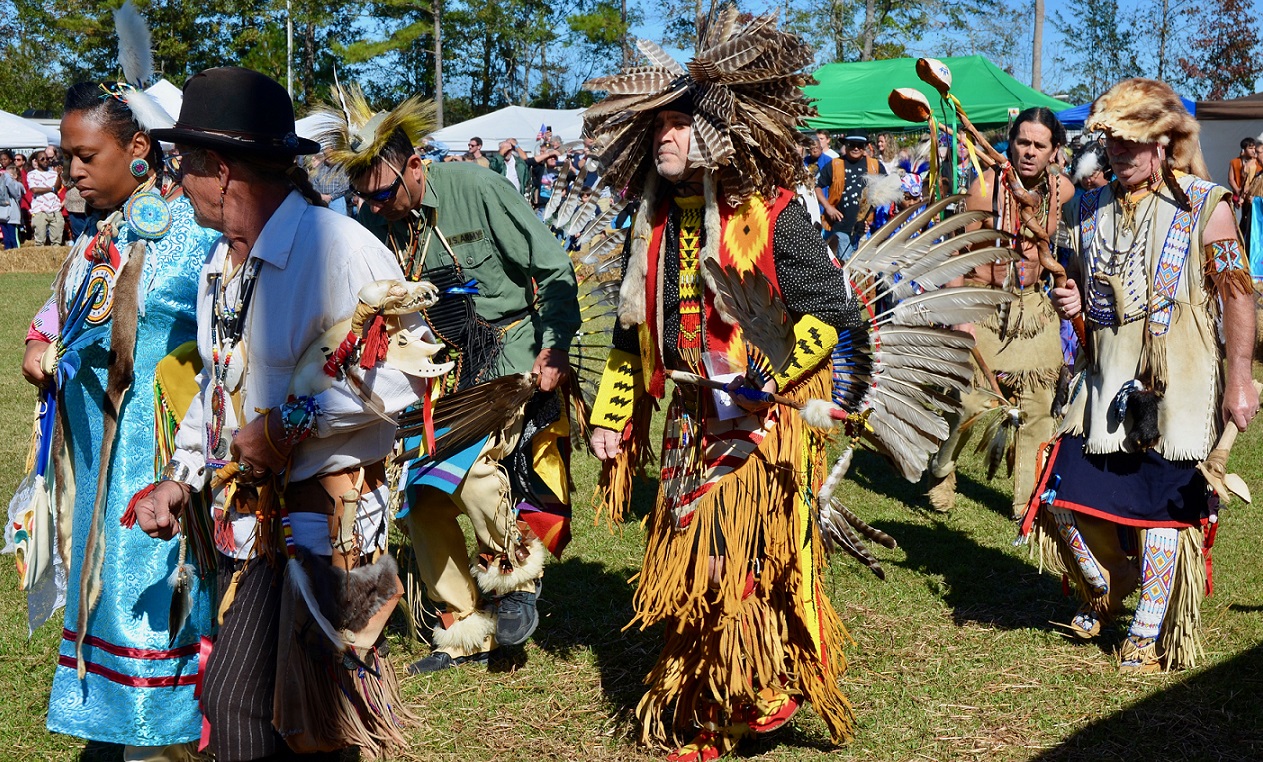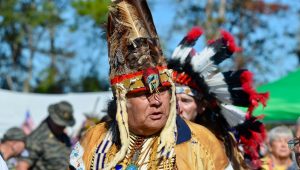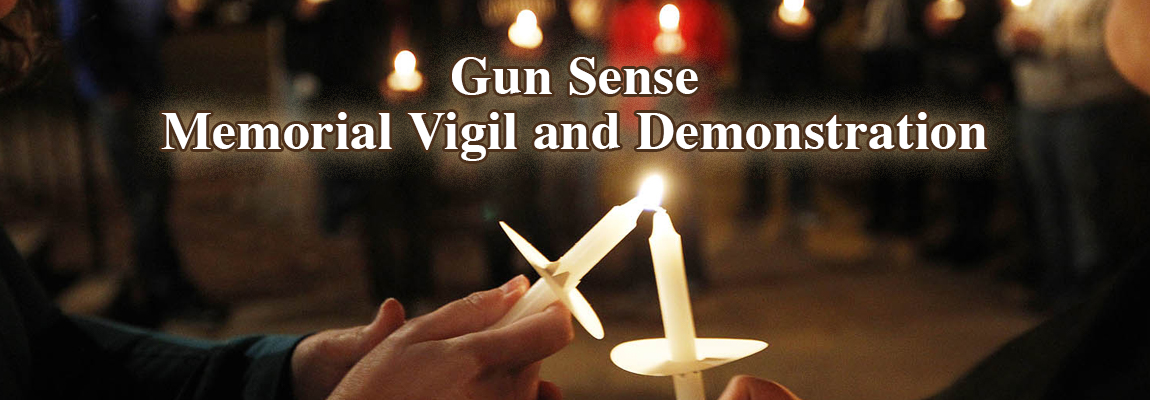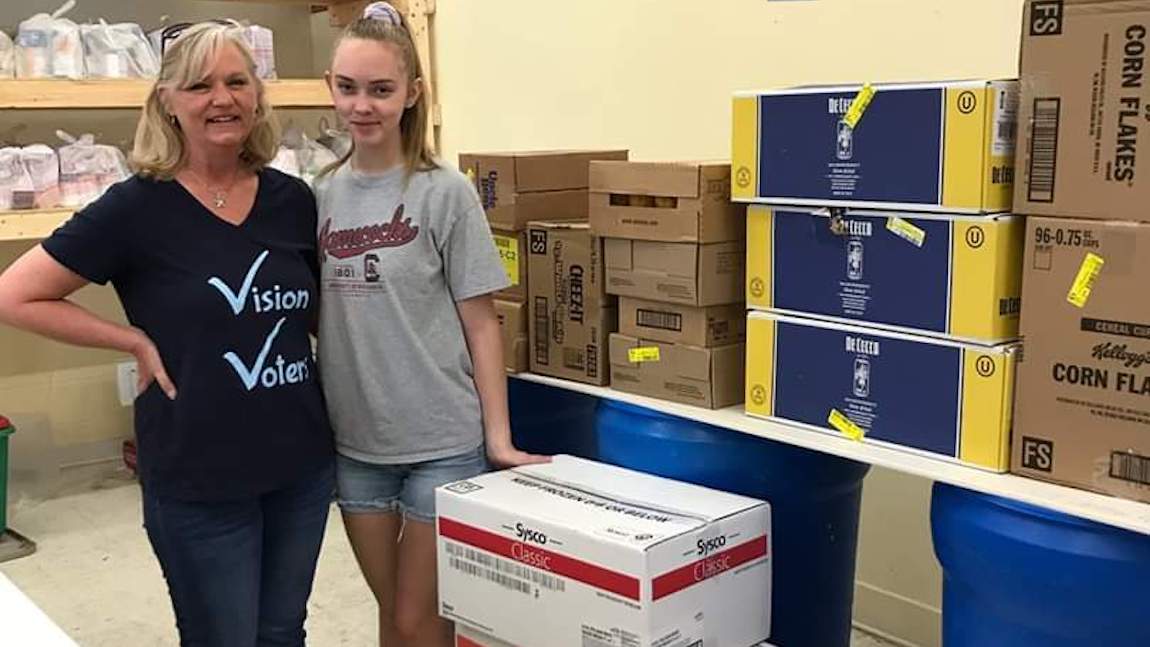Above Photo: Opening Parade at the 2018 Waccamaw Pauwau
By V. Susan Hutchinson
In August 1990, President George H.W. Bush declared November National American Indian Heritage Month. It is now more commonly referred to as Native American Heritage Month. This recognition was a long time coming and falls far short of America’s commitment to the native people of this land.
As Europeans discovered the riches in the New World, they felt a divine right to take it at any cost. So began the removal and genocide of the native people who, to this day, still struggle to survive in a culturally divided nation.
In the words of Mark Charles, 2020 Independent Presidential Candidate and member of the Navajo nation, “’We the people’ has never meant ‘all the people’”.
The Trail of Broken Promises
The Treaty of Hopewell was the first attempt at a reservation system for Native Americans in 1785. The goal was to protect the Cherokee people and allow them to live as they always had; however, it did not keep white settlers from encroaching on their land, resulting in revolt from the Cherokee. The early 19th Century brought forced migration of the Cherokee and four other “civilized” tribes across the Mississippi River purely to obtain their land.
Between 1778 and 1871 there were 370 treaties signed with the intent of establishing land boundaries, hunting and fishing rights and American protection of native people from white enemies. These treaties were continually broken as greedy, white Americans moved westward.
As the reservation system grew, so did the Native American dependence on the American government for food, clothing and other subsistence. The result was a once independent people relying on a government that does not prioritize their needs.
In 1988 the Indian Gaming Regulatory Act was approved and reservations began to build casinos. Not all reservations have casinos and most that do barely make a profit. Indian gaming did not resolve social issues on the reservation or make tribes independent, so the cycle of poverty continues to this day.
How Bad Is it?
According to the Center for Native American Youth at the Aspen Institute the following data applies to American Indian and Alaskan Native (AI/AN) people.
- The Indian Health Service estimates annual Congressional appropriations only meet 52% of health care needs with 24.1% who lack health insurance coverage and relying solely on the Indian health system.
- The poverty rate in 2009 was 23.6% with 32.4% of those under 18 living in poverty.
- Although the average income is $33,300, those living in Indian Country (e.g. on reservations) have incomes less than half the national average of $46,200.
- Alcoholism mortality is 514% higher than the general population.
- Suicide rates are more than double with Native American teens having the highest rate of suicide of any U.S. population group.
- Diabetes is 177% higher with the highest rate of Type 2 diabetes than any other population.
- Tuberculosis is 500% higher.
- The national graduation rate from high school was 49.3% for 2003-2004 compared to 76.2% for whites with only 13.3% having undergraduate degrees.
Approximately 2% of children in the U.S. are AI/AN, but represent 8.4% of children in foster care. Violence, injuries, homicide and suicide account for 75% of deaths for ages 12-20.
The statistics on violence against Native American women is staggering. More than four in five AI/AN have experienced violence with more than one in two experiencing sexual violence. Alaskan Native women have the highest rate of sexual assault and rates of domestic violence, up to 10 times higher than the rest of the country. On some reservations, Indian women are murdered at a rate of more then 10 times the national average.
The Indian Child Welfare Act (ICWA) was created to address the large number of family separations of Native children. Research showed that 25-35% of all AI/AN children were being removed with 85% placed outside of families and communities, even when relatives were available to take them in. Even with this law in place, out-of-home placement is still more frequent for AI/AN children than for the general population.
Native American Challenges Today and the Trump Administration
The struggle to maintain cultural identity and work within unjust government policies continues to this day. This is seen in the case of the local Waccamaw Indian Nation where Chief Harold “Buster” Hatcher fights with the federal government on a regular basis for the needs of his tribe, even for the right to bury their ancestors.
Hatcher often talks about how white America confiscated his ancestors’ lands here in Horry County and even suggests there is a legal case for his organization to seek, in court, the return of those lands – virtually all of Horry County. For now, that is not the tribe’s strategy as it focuses on gaining official recognition from the federal government.
Harold Hatcher, Chief of the Waccamaw Nation
And now we are living under the Trump Administration.
The anti-environment policies of Donald Trump are devastating for many Indian Nations, especially western tribes. In 2017 Trump signed orders to begin construction on the Keystone XL and Dakota Access pipelines, a rollback of an Obama environmental policy. The Dakota Access pipeline runs beneath a lake near the Standing Rock Sioux reservation and threatens not only local water resources, but sacred sites. The pipeline has leaked at least 5 times in 2017 alone.
In addition to the environmental issues around pipelines, Trump wants to make protests of pipelines, mostly by Native Americans, a federal crime. However, in October 2019, the ACLU, along with other groups, succeeded in stopping the enforcement of the South Dakota “riot-boosting” law, which infringed upon the right to free speech.
Donald Trump’s assault on Native Americans continued last week when he proclaimed November as National American History and Founders Month. His proclamation about Native American History Month came out five days later and it failed to appropriately recognize Native Americans during a decades old federally designated observance. The new proclamation is perceived by some as a thinly veiled way to now recognize white nationalism. The message to Native Americans was clear.
“This administration is trying to erase us.”
Moving Forward
This week the South Carolina Indian Affairs Commission, partnered with the USC College of Social Work, to conduct an online survey collecting data on Native American women and children in South Carolina. They hope to gain insight into experiences with the Department of Social Services and the foster care system. The goal is to gather enough supporting data to advocate for Native women and communities. The deadline to complete the survey is November 13, 2019.
The Native Americans of the United States continue their struggle for basic services and opportunities currently, through no fault of their own, out of reach to them. We, as Americans, need to help in this fight by electing officials who will listen to their needs and work toward improvements that are long overdue.
Take a Stand for Native American Rights in 2020.







